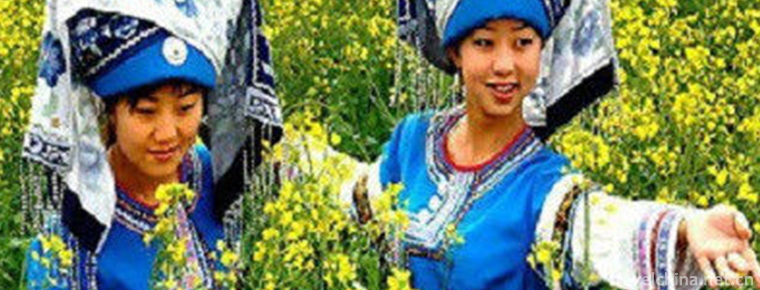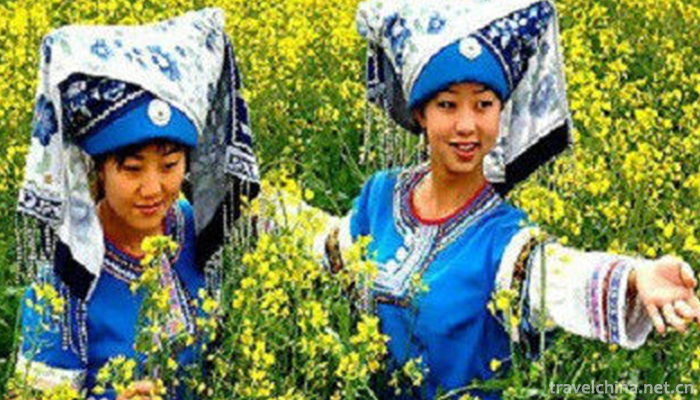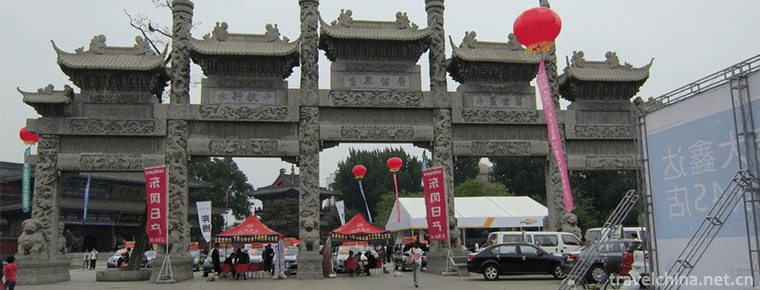2019-01-13

- By ChinaWiki.net
- Chinese Edition
- 2019-04-04
Bouyei Pange
Bouyei Pange is a traditional folk song of the Bouyei nationality. It is a folk literary work created and sung in the original Bouyei language. Bouyei Pange is popular in Buyi villages in the Beipanjiang valley of Guizhou Province, especially in Yangchang, Panxian, Liupanshui City, where the Bai and Miao Pange is the most representative.
On June 7, 2008, "Bouyei Pange" declared by Panxian County, Guizhou Province, was approved by the State Council to be included in the second batch of national intangible cultural heritage list.
historical origin
Following the formation of the Buyi ethnic group, Pange of the Buyi ethnic group sprouted, formed in the Spring and Autumn Period and the Warring States Period, and spanned the historical process of human society after the formation of the Buyi ethnic group.
Bouyei Pange has been circulated in Bouyei villages in Beipanjiang valley since ancient times, and has a long history of inheritance. Because the Buyi people do not have their own words, they can only carry civilization by singing and inherit culture by singing. Pange is one of the important tools for the Buyi people to record history, express emotions, educate their children, judge society and reproduce life.
According to the lyrics of the Bouyei Pange, the Bouyei people lived in the basin of the North and South Panjiang River very early. During the Spring and Autumn Period and the Warring States Period, the Luoyue people belonged to the subjects of the Yao State, and still preserved many of the life customs and cultural characteristics of the ancient Luoyue people.
The Buyi people were called Puyue before Qin Dynasty, Pu Liao in Han Dynasty and Six Dynasties, Man and Fan in Tang, Song and Yuan Dynasty, Zhongjia from Ming and Qing Dynasties to the end of Republic of China. In 1953, after national identification and according to national wishes, the state unified the name of Buyi as a clan.
Cultural characteristics
content
Bouyei pan songs mainly include ancient songs, wine songs, love songs, sacrificial songs, ritual songs and so on. The content involves labor, current affairs, rituals, love, living environment, historical legends and many other aspects, singing in a variety of tunes on occasions such as marriage and funeral, ushering and sending, productive labor, leisure and entertainment, love and so on. It also involves many fields such as politics, economy, culture, society, ethics and morality, religion, etc. It vividly describes the unique psychological characteristics and emotional tendencies of Buyi people, and is an important carrier for the Buyi people to record their national history and culture.
type
According to the content of the lyrics, there are:
1. Historical legendary songs: including ancient songs, legendary stories and so on. They are sung in the form of wine songs. Generally speaking, they have a long length, including gods, ancestors, ethnic origins, society, nature, figures, history, etc.
2. Labor song: directly narrate the specific production and labor process of all walks of life, express the working people's sense of labor and the pleasure gained through labor, etc. The content is mostly related to the production of labor songs. Such as "Yangko transplanting", "Song of Lanjie", "Song of embroidery", "Song of planting beans" and so on.
3. Ritual songs: They are mostly used in marriage, funeral, sacrifice and other occasions. They have a more fixed form. Besides specific marriage, funeral, marriage and marriage etiquette, they also involve astronomy, geography, historical legends, emotional accidents, seasonal seasons, etc. They are often sung by male and female singers in pairs. Such as "Pay Niang En", "Cry Niang Song", "Sacrifice Mountain Song", "Goddess Song" and so on.
4. Love song: It is the most abundant and abundant part of Bouyei folk songs. The content of love songs is mostly related to love. From acquaintance to marriage, there are various stages of expression, covering the whole process of marriage and love. Such as the first acquaintance of "acquaintance song", "first meeting song", "test heart song", "love song" and so on. Expressing love, such as Love Song, Date Song, Ding You Song, etc. Those who express their love are "Don't Forget Songs", "Hand in Hand Songs" and "Marriage Songs of Choosing Days". Expressing infatuation, such as "Song of Life and Death", "Song of Xu Death", "Missing Love Sisters such as Lost Soul" and so on.
According to the singing occasions, it can be divided into indoor singing and field singing. Indoor singing is mainly performed on occasions of marriage, funeral and sacrifice, while field singing is mainly performed on occasions of love and romance between men and women.
According to the singing tune, it can be divided into love tune, etiquette tune, wedding tune, funeral tune and so on.
Love songs begin with the pronunciation words "meaning, meaning, ah..."; etiquette and ethical tunes begin with the pronunciation words "ah Erliwei Friends... Ni"; wedding tunes begin with the pronunciation words "ah, ah... ah pity"; funeral tunes begin with the pronunciation words "ah throat... ah throat".
Buyi disc songs can be sung in solo or accompanied by musical instruments. Some are singers singing while playing, others are singing alone, many people accompanied by instruments.
Musical Instruments
The instruments used for accompaniment are:
1. Yueqin: Bouyei is called "bullet", which has 11 or 12 grades. Playing without shrapnel, directly with fingers.
2. Bamboo flute: big, medium and small, that is, high, medium and bass. There are flute holes. There are six press holes and one blow hole.
3. Shaoguan: a wind instrument, popular in Yunnan, Guizhou Province Buyi, Miao, Yi areas. Made of bamboo, 30-40 cm in length. There are 5-7 sound-pressing holes on the bamboo pipe. A cork is blocked at the top of the pipe and a sound hole is opened at the back of the cork. Soft voice and color, for daily entertainment life.
4. Wood leaves: Camphor leaves and holly leaves are often used to blow melodies with a clear and melodious voice. Soft, thin, smooth leaves can be used to play. These instruments can be played alone or in concert.
form
Bouyei pan songs mainly include ancient songs, wine songs, love songs, sacrificial songs, ritual songs and so on. The content involves labor, current affairs, rituals, love, living environment, historical legends and many other aspects, singing in a variety of tunes on occasions such as marriage and funeral, ushering and sending, productive labor, leisure and entertainment, love and so on. It also involves many fields such as politics, economy, culture, society, ethics and morality, religion, etc. It vividly describes the unique psychological characteristics and emotional tendencies of Buyi people, and is an important carrier for the Buyi people to record their national history and culture.
According to the content of the lyrics, there are:
1. Historical legendary songs: including ancient songs, legendary stories and so on. They are sung in the form of wine songs. Generally speaking, they have a long length, including gods, ancestors, ethnic origins, society, nature, figures, history, etc.
2. Labor song: directly narrate the specific production and labor process of all walks of life, express the working people's sense of labor and the pleasure gained through labor, etc. The content is mostly related to the production of labor songs. Such as "Yangko transplanting", "Song of Lanjie", "Song of embroidery", "Song of planting beans" and so on.
3. Ritual songs: They are mostly used in marriage, funeral, sacrifice and other occasions. They have a more fixed form. Besides specific marriage, funeral, marriage and marriage etiquette, they also involve astronomy, geography, historical legends, emotional accidents, seasonal seasons, etc. They are often sung by male and female singers in pairs. Such as "Pay Niang En", "Cry Niang Song", "Sacrifice Mountain Song", "Goddess Song" and so on.
4. Love song: It is the most abundant and abundant part of Bouyei folk songs. The content of love songs is mostly related to love. From acquaintance to marriage, there are various stages of expression, covering the whole process of marriage and love. Such as the first acquaintance of "acquaintance song", "first meeting song", "test heart song", "love song" and so on. Expressing love, such as Love Song, Date Song, Ding You Song, etc. Those who express their love are "Don't Forget Songs", "Hand in Hand Songs" and "Marriage Songs of Choosing Days". Expressing infatuation, such as "Song of Life and Death", "Song of Xu Death", "Missing Love Sisters such as Lost Soul" and so on.
According to the singing occasions, it can be divided into indoor singing and field singing. Indoor singing is mainly performed on occasions of marriage, funeral and sacrifice, while field singing is mainly performed on occasions of love and romance between men and women.
According to the singing tune, it can be divided into love tune, etiquette tune, wedding tune, funeral tune and so on. Love songs begin with the pronunciation words "meaning, meaning, ah..."; etiquette and ethical tunes begin with the pronunciation words "ah Erliwei Friends... Ni"; wedding tunes begin with the pronunciation words "ah, ah... ah pity"; funeral tunes begin with the pronunciation words "ah throat... ah throat". Buyi disc songs can be sung in solo or accompanied by musical instruments. Some are singers singing while playing, others are singing alone, many people accompanied by instruments.
The instruments used for accompaniment are:
1. Yueqin: Bouyei is called "bullet", which has 11 or 12 grades. Playing without shrapnel, directly with fingers.
2. Bamboo flute: big, medium and small, that is, high, medium and bass. There are flute holes. There are six press holes and one blow hole.
3. Shaoguan: a wind instrument, popular in Yunnan, Guizhou Province Buyi, Miao, Yi areas. Made of bamboo, 30-40 cm in length. There are 5-7 sound-pressing holes on the bamboo pipe. A cork is blocked at the top of the pipe and a sound hole is opened at the back of the cork. Soft voice and color, for daily entertainment life.
4. Wood leaves: Camphor leaves and holly leaves are often used to blow melodies with a clear and melodious voice. Soft, thin, smooth leaves can be used to play.
These instruments can be played alone or in concert.
Inheritance significance
Bouyei Pange has a wide range of popularity and folk inheritance. It is a long narrative song with rich contents of human origin, Bouyei origin, production and labor, treatment of people, ethics and morality, marriage and building houses, funeral and sacrifice.
In the long oral transmission process, every Buyi is a singer. Everyone sings in labor, in life and in festivals, forming a variety of versions of the Boyi tray songs.
Generally speaking, Bimo and matchmaker have more standardized singing methods in the activities of marriage, sacrifice and funeral rites. Singing in Bouyei language is another basic feature of the inheritance of Bouyei folk songs. As a long narrative poem, Bouyei folk songs should be read aloud, but in fact, they are mainly sung.
There are many kinds of tunes used to sing Buyi pan songs. People of different ages, sexes and regions choose their own tunes when singing different paragraphs.
Bouyei folk songs can be sung solo or in pairs. They can also be sung by one person and led by others. The lead singer sings the contents of the poems and the crowd sings the lining words. Most of them are sung in the narrative tunes of "happy tune", "old man tune" and "sad tune".
Bouyei Pange is an important carrier for the Bouyei people to record their national history and culture. It is rooted in the cultural tradition or history of the Bouyei people and plays a role in confirming their cultural identity. It has become a representative "business card" of the Bouyei people.
Inheritance status
Due to the fact that Bouyei folk songs have been sung in Bouyei language all the time and the lack of traditional Bouyei characters, so far, few people of other nationalities can sing except Bouyei. In the villages inhabited by Bouyei people in Yangchang Township, with the death of many old singers and the increasing number of young migrant workers in recent years, there are only a few people in the village who can sing Bouyei folk songs completely. The situation is very endangered, rescue and protection is imminent.


Ask a Question
Your email address will not be published.



0 Questions